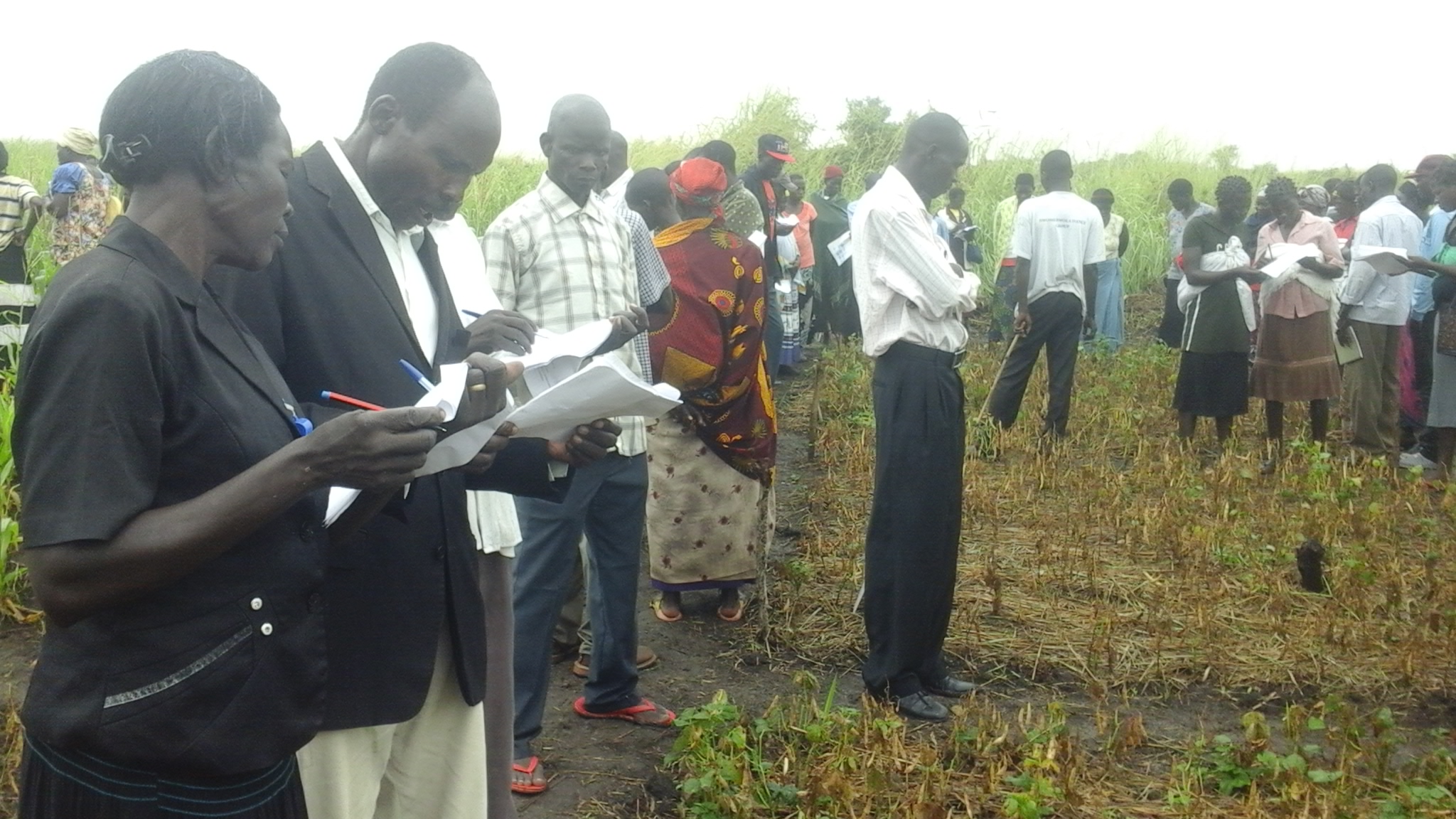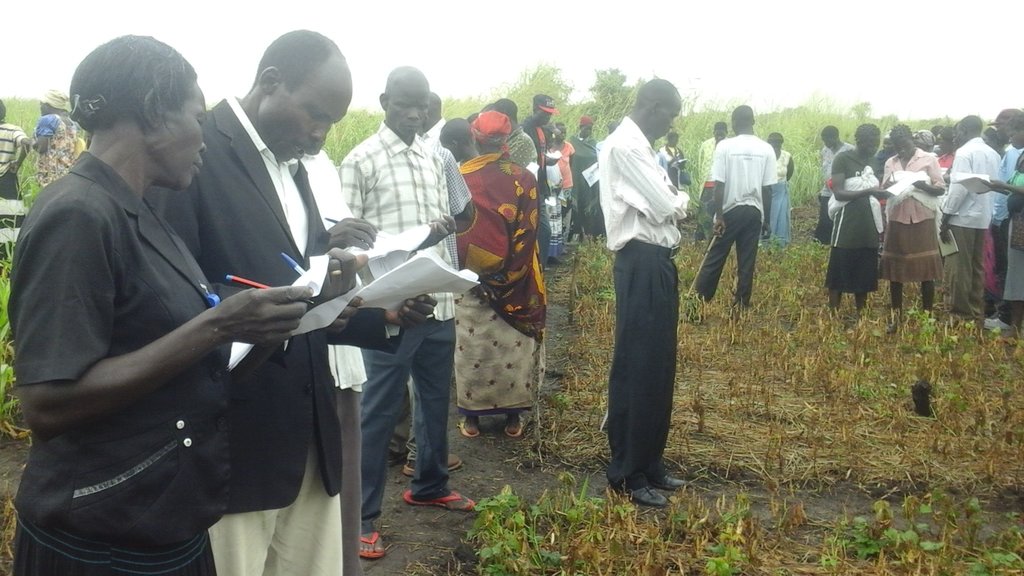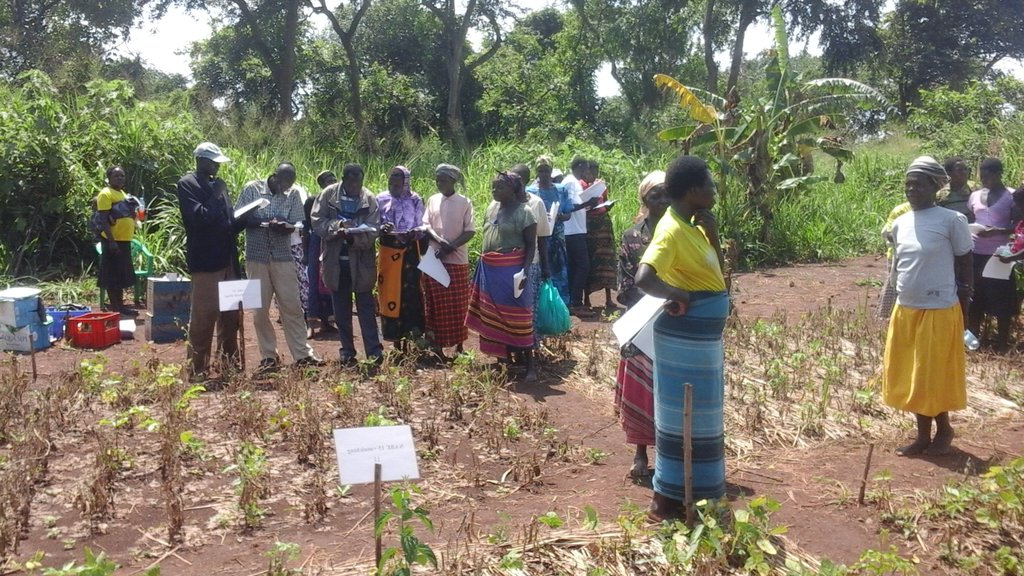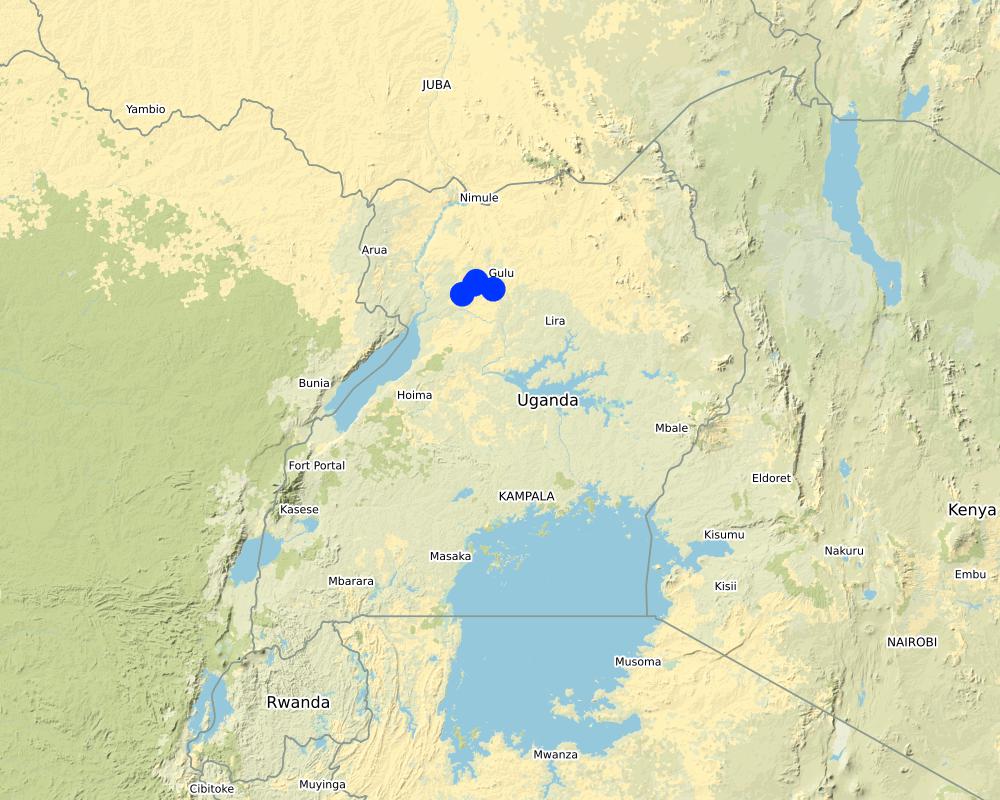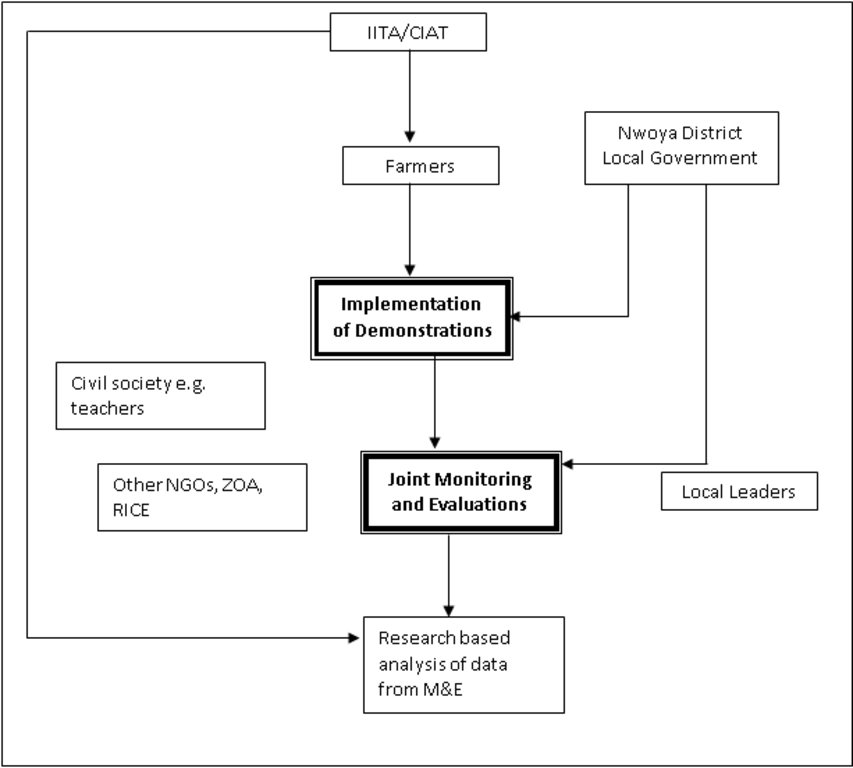Participatory Monitoring and Evaluation of Demonstration Plots [Uganda]
- Creation:
- Update:
- Compiler: Sunday Balla Amale
- Editor: JOY TUKAHIRWA
- Reviewer: Udo Höggel
Lwak kamoko ber pa diro
approaches_3370 - Uganda
View sections
Expand all Collapse all1. General information
1.2 Contact details of resource persons and institutions involved in the assessment and documentation of the Approach
Name of project which facilitated the documentation/ evaluation of the Approach (if relevant)
Scaling-up SLM practices by smallholder farmers (IFAD)Name of the institution(s) which facilitated the documentation/ evaluation of the Approach (if relevant)
Makerere University (Makerere University) - Uganda1.3 Conditions regarding the use of data documented through WOCAT
When were the data compiled (in the field)?
14/11/2017
The compiler and key resource person(s) accept the conditions regarding the use of data documented through WOCAT:
Ja
2. Description of the SLM Approach
2.1 Short description of the Approach
In Participatory Monitoring and Evaluation of demonstrations, all the players or stakeholders involved in the implementation of the demonstration come together to carry out a joint monitoring and evaluation of the performance of the technology being implemented.
2.2 Detailed description of the Approach
Detailed description of the Approach:
Demonstration plots established to train farmers are common channels through which recommended farming practice(s) are demonstrated to local farmers. During this process, all the relevant stakeholders in the agricultural sector, for example farmers, local leaders and government extension officers, partner organisations, and the lead implementing agency plan together on how best to implement the demonstration with emphasis on the host community, their roles and responsibilities so as to ensure successful implementation of the demonstration.
Stakeholders involved include:
•Group and community members (women, youth and men)
•Local leaders and authorities
•Civil servants
•Partner Non-Governmental Organisations (NGOs)
•Lead implementing agencies (International Institute of Tropical Agriculture, IITA and International Center for Tropical Agriculture, CIAT)
For the subsequent monitoring and evaluation (M&E) process, the participating stakeholders are invited for a field day on the site of the demonstration. Such M&E process is performed twice or three times during implementation of the demonstration activities depending on necessity, availability of time and resources. The M&E tool is designed by the M&E officer in the organization (IITA/CIAT) supported by the Field Officer/Research Assistant who is responsible for carrying out the field activities. The emphasis of the M&E process is on the goals and objectives, sustainability and adaptive nature, socio-economic and political environment, gender and policy considerations and impacts of the project being implemented. Group members help identifying the stakeholders in their community who can be resourceful in evaluating the demonstrations.
The Participatory Monitoring and Evaluation (PM&E) of the demonstration process, activities and performance is then carried out. It aims to:
•Assess the technology/practice(s) in question in terms of crop vigour and yield
•Understand the resilience of the practice to local prevailing climatic and weather conditions
•Assess whether equal opportunity was given for all community members to participate
•Assess the level of cooperation among group members during meetings
•Understand the gender perspectives with regard to gender equality, woman and youth involvement
•Test for the benefits, performance, pros and cons, and the opportunity cost involved in adopting a demonstrated technology
The PM&E questionnaire is based on IITA/CIAT PM&E tool and is composed of the following chapters:
1.Socio-demographic characteristics: district, sub-county, village, name, telephone contact, age, sex, educational level, employment and group-membership of the participant.
2.Farming characteristics: years of farming experience, total amount of land owned and allocated for farming or particular technology of interest, type of seed (local or improved) and the variety of the crop in question, source of seed and whether or not the participant participated in implementing the demonstration.
3.Implementation performance: Demo-plot location, distance, farmer trainings, demo-management, partnerships in the implementation, participation, cooperation, importance, relevance, monitoring of the demo, involvement in terms of community, gender, youth and the vulnerable groups and attendance.
4.Crop performance: Germination percentage, crop vigour, plant height, number of pods/cobs, pod/cob filling, maturity duration, yield, soil quality, pest occurrence, disease and drought resistance/tolerance.
5.Agro-ecological benefits: This can be ranked in terms of importance of the practice for soil fertility and bio-diversity, adaptation to weather variability and climate change.
6.Socio-economic benefits: This is ranked based on importance for household food and nutrition security, source of income, labour demands and cost of implementation.
7.Participants are then required to rank the technologies monitored.
The scale of ranking ranges from 1 to 5, where 1=Very Unhappy, 2=Unhappy, 3=neither Happy nor Unhappy, 4=Happy, 5=Very Happy. For certain questions, emoji illustrations are also used for the monitoring process.
2.3 Photos of the Approach
2.5 Country/ region/ locations where the Approach has been applied
Country:
Uganda
Region/ State/ Province:
Northern Uganda
Further specification of location:
Nwoya District
Map
×2.6 Dates of initiation and termination of the Approach
If precise year is not known, indicate approximate date when the Approach was initiated:
less than 10 years ago (recently)
2.7 Type of Approach
- project/ programme based
2.8 Main aims/ objectives of the Approach
All stakeholders appreciate their involvement and hence adopt the technology for purposes of learning and knowledge sharing
2.9 Conditions enabling or hindering implementation of the Technology/ Technologies applied under the Approach
social/ cultural/ religious norms and values
- enabling
Corperation among all stakeholders
- hindering
Time and resource needed to bring all stakeholders together
availability/ access to financial resources and services
- enabling
This approach enables joint presentation and contribution of projects for funding
institutional setting
- enabling
Local farmer groups are activated , share knowledge and information
- hindering
Bureaucratic processes in decision making to participate in the process
collaboration/ coordination of actors
- enabling
Common interest in sustainable agriculture and support to farmer activities
legal framework (land tenure, land and water use rights)
- enabling
Presence of rules and regulations that bind the stakeholders to jointly monitor and evaluate as a team
- hindering
Poor and weak implementation and enforcement of rules and regulations
policies
- enabling
Local and national policies on bottom up approach where all stakeholders are involved in decision making, starting from the lowest
land governance (decision-making, implementation and enforcement)
- enabling
People are able to come together to participate in an activity that is related to land management
- hindering
Divergent interests and expectations during monitoring and evaluation
knowledge about SLM, access to technical support
- enabling
Learning about SLM from the process of monitoring and evaluation
markets (to purchase inputs, sell products) and prices
- enabling
Affordable prices and quality inputs
- hindering
Exploitation by middle men and use of expired inputs on demonstration plots
workload, availability of manpower
- enabling
Shared roles and responsibilities among men and women during monitoring and evaluation
- hindering
Dominance resulting into conflicts over roles and responsibilities
other
- enabling
Presence of monitoring and evaluation committee
- hindering
Understanding roles and responsibilities of the participatory monitoring and evaluation committee
3. Participation and roles of stakeholders involved
3.1 Stakeholders involved in the Approach and their roles
- local land users/ local communities
Farmers
Establish the demonstration, carry out activities in demonstrations, monitor and evaluate the demonstration
- community-based organizations
Local CBOs
Partipate in M&E of the demonstration
- researchers
International Institute of Tropical Agriculture (IITA), International Center for Tropical Agriculture (CIAT)
Introduced the monitoring / evaluation approach, participate in the monitoring process
- teachers/ school children/ students
Teachers from local schools
Participate in monitoring / evaluation
- NGO
Organisation ZOA - from relief to recovery (https://www.zoa-international.com/), other local NGOs
Participate in monitorng / evaluation
- local government
Subcounty and District officials
Participate in monitorng / evaluation
If several stakeholders were involved, indicate lead agency:
International Institute of Tropical Agriculture-IITA
3.2 Involvement of local land users/ local communities in the different phases of the Approach
| Involvement of local land users/ local communities | Specify who was involved and describe activities | |
|---|---|---|
| initiation/ motivation | interactive | Farmers and local leaders |
| planning | external support | Support from IITA |
| implementation | interactive | Farmers, Local leaders, Partner NGOs, IITA |
| monitoring/ evaluation | interactive | Farmers, Local leaders, Partner NGOs, Policy makers |
| Publication of output | passive | IITA as the organisation implementing the project |
3.3 Flow chart (if available)
Description:
Flow chart showing process that leads to the implementation of participatory monitoring and evaluation
Author:
Sunday Balla
3.4 Decision-making on the selection of SLM Technology/ Technologies
Specify who decided on the selection of the Technology/ Technologies to be implemented:
- all relevant actors, as part of a participatory approach
Specify on what basis decisions were made:
- evaluation of well-documented SLM knowledge (evidence-based decision-making)
4. Technical support, capacity building, and knowledge management
4.1 Capacity building/ training
Was training provided to land users/ other stakeholders?
Ja
Specify who was trained:
- land users
- field staff/ advisers
Form of training:
- demonstration areas
4.2 Advisory service
Do land users have access to an advisory service?
Ja
- Demonstration sites identified by farmers
4.3 Institution strengthening (organizational development)
Have institutions been established or strengthened through the Approach?
- yes, moderately
Specify the level(s) at which institutions have been strengthened or established:
- local
- regional
- national
Specify type of support:
- capacity building/ training
4.4 Monitoring and evaluation
Is monitoring and evaluation part of the Approach?
Ja
Comments:
It is the exact approach
If yes, is this documentation intended to be used for monitoring and evaluation?
Ja
4.5 Research
Was research part of the Approach?
Ja
Specify topics:
- ecology
Give further details and indicate who did the research:
IITA-Climate Smart Agriculture Research. Research focused on increasing food security and farming systems' resilience in East Africa
5. Financing and external material support
5.1 Annual budget for the SLM component of the Approach
If precise annual budget is not known, indicate range:
- 2,000-10,000
5.2 Financial/ material support provided to land users
Did land users receive financial/ material support for implementing the Technology/ Technologies?
Nee
5.3 Subsidies for specific inputs (including labour)
- none
If labour by land users was a substantial input, was it:
- voluntary
5.4 Credit
Was credit provided under the Approach for SLM activities?
Nee
5.5 Other incentives or instruments
Were other incentives or instruments used to promote implementation of SLM Technologies?
Ja
If yes, specify:
Refreshments during PM&E and demonstration activities eg. water or soft drinks
6. Impact analysis and concluding statements
6.1 Impacts of the Approach
Did the Approach empower local land users, improve stakeholder participation?
- No
- Yes, little
- Yes, moderately
- Yes, greatly
Local users understand what kind of paramenters can be considered for an evaluation
Did the Approach enable evidence-based decision-making?
- No
- Yes, little
- Yes, moderately
- Yes, greatly
The approach enables farmers to take decisions based on what they observed during the evaluation process
Did the Approach improve coordination and cost-effective implementation of SLM?
- No
- Yes, little
- Yes, moderately
- Yes, greatly
All stakeholders took part in the implementation and PM&E process. This improved coordination and resource sharing
Did the Approach mobilize/ improve access to financial resources for SLM implementation?
- No
- Yes, little
- Yes, moderately
- Yes, greatly
Stakeholder platform helps to share and identify potential sources of resource and fund mobilisation
Did the Approach improve knowledge and capacities of land users to implement SLM?
- No
- Yes, little
- Yes, moderately
- Yes, greatly
Each participant understood in depth the process involved in implementing a given technology
Did the Approach improve knowledge and capacities of other stakeholders?
- No
- Yes, little
- Yes, moderately
- Yes, greatly
Participants learned important indicators for demonstrations and how to assess them
Did the Approach build/ strengthen institutions, collaboration between stakeholders?
- No
- Yes, little
- Yes, moderately
- Yes, greatly
Many stakeholders were part of the platform, ranging from local schools and institutions as part of the civil society
Did the Approach mitigate conflicts?
- No
- Yes, little
- Yes, moderately
- Yes, greatly
Participants learned how to collaborate in groups
Did the Approach empower socially and economically disadvantaged groups?
- No
- Yes, little
- Yes, moderately
- Yes, greatly
All community members were invited to learn and participate hence acquiring knowledge
Did the Approach improve gender equality and empower women and girls?
- No
- Yes, little
- Yes, moderately
- Yes, greatly
The approach involved all age groups and gender with focus on widows
Did the Approach encourage young people/ the next generation of land users to engage in SLM?
- No
- Yes, little
- Yes, moderately
- Yes, greatly
Youth were at the forefront of implementation
Did the Approach improve issues of land tenure/ user rights that hindered implementation of SLM Technologies?
- No
- Yes, little
- Yes, moderately
- Yes, greatly
Participants learned about the importance of learning and the allocation for various activities. ZOA carried out land and conflict resolutions and helped farmers acquiring land titles from the Government
Did the Approach lead to improved food security/ improved nutrition?
- No
- Yes, little
- Yes, moderately
- Yes, greatly
Participants identify which technology addresses their food and nutrition security needs
Did the Approach improve access to markets?
- No
- Yes, little
- Yes, moderately
- Yes, greatly
Farmers identify which technology is a suitable income basing on the available market opportunities
Did the Approach lead to improved access to water and sanitation?
- No
- Yes, little
- Yes, moderately
- Yes, greatly
The approach utilized local community group which also carry out Savings, borehole maintenance and community Village Health teams
Did the Approach improve the capacity of the land users to adapt to climate changes/ extremes and mitigate climate related disasters?
- No
- Yes, little
- Yes, moderately
- Yes, greatly
Farmers identify technologies, resilient to weather variability and weather extremes
6.2 Main motivation of land users to implement SLM
- increased production
High yields of crops
- increased profit(ability), improved cost-benefit-ratio
Market available for the products from SLM technology
- reduced land degradation
Soil and fertility management
- reduced risk of disasters
Reduced risks of drought, pest and disease incidences, floods
6.3 Sustainability of Approach activities
Can the land users sustain what has been implemented through the Approach (without external support)?
- yes
If yes, describe how:
During the PM&E Process, the land users are required to indicate their interest in the adoption of particular technologies and the challenges they would face. Therefore this process enables the farmers to know the requirements for implementing a given technology, pros and cons and how to sustain it economically and environmentally.
6.4 Strengths/ advantages of the Approach
| Strengths/ advantages/ opportunities in the land user’s view |
|---|
| It is participatory |
| All stakeholders are involved |
| Individual opinions is considered |
| Strengths/ advantages/ opportunities in the compiler’s or other key resource person’s view |
|---|
| It is a research based approach and quantitative data can be obtained from such an approach |
| Basic sign and labels on the PM&E tool is easy for local farmers to understand |
6.5 Weaknesses/ disadvantages of the Approach and ways of overcoming them
| Weaknesses/ disadvantages/ risks in the land user’s view | How can they be overcome? |
|---|---|
| The participants may not understand clearly what information is required of them. This can be due to misunderstanding of questions, indicators and possible responses if they are not properly explained. | Eloquent speaker of the local language should act as enumerator to clearly explain what is required of the participants. This can be coupled with emoji illustrations besides the questionnaire. |
| Weaknesses/ disadvantages/ risks in the compiler’s or other key resource person’s view | How can they be overcome? |
|---|---|
| Simple, visible and easy to understand attributes or parameters are considered. for example plant yield, vigor, participation. Some factors like long term benefits, cost benefit considerations were not included. | Perceptions and Attitudes, Simple cost benefit considerations can be included in the evaluation. |
7. References and links
7.1 Methods/ sources of information
- field visits, field surveys
All stakeholders involved during the field day activity should participate in the PM&E
Links and modules
Expand all Collapse allLinks
No links
Modules
No modules


